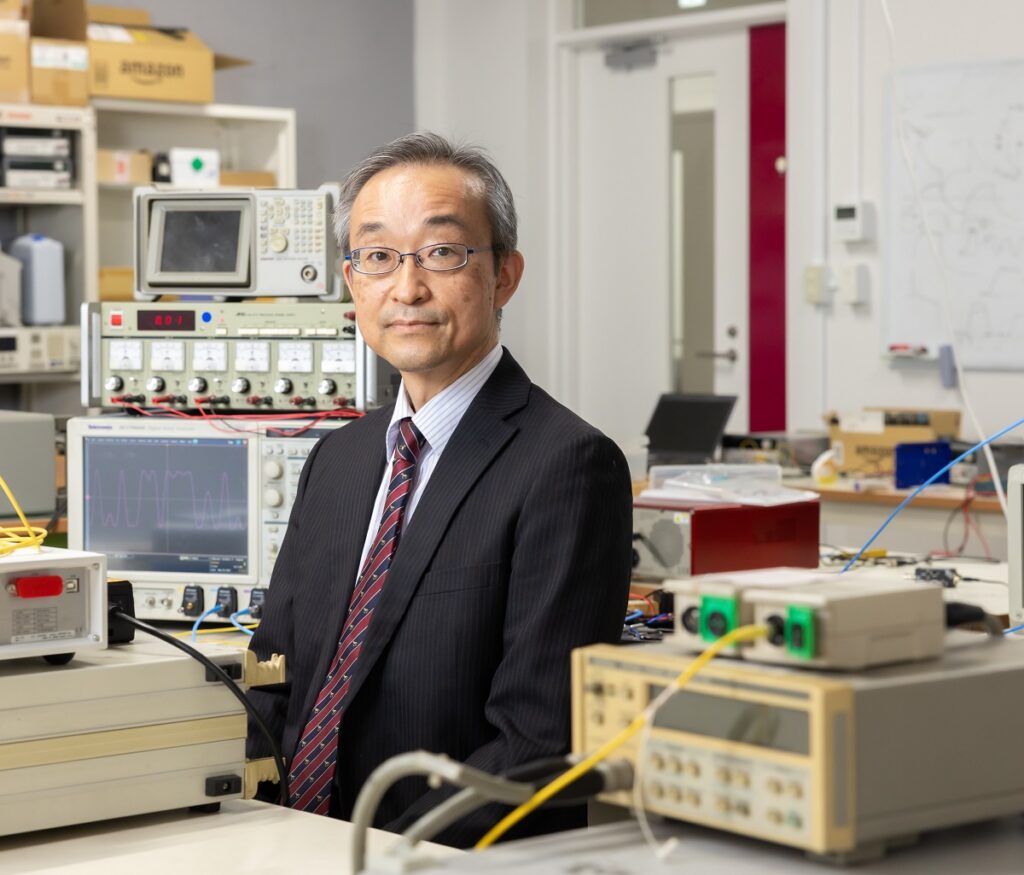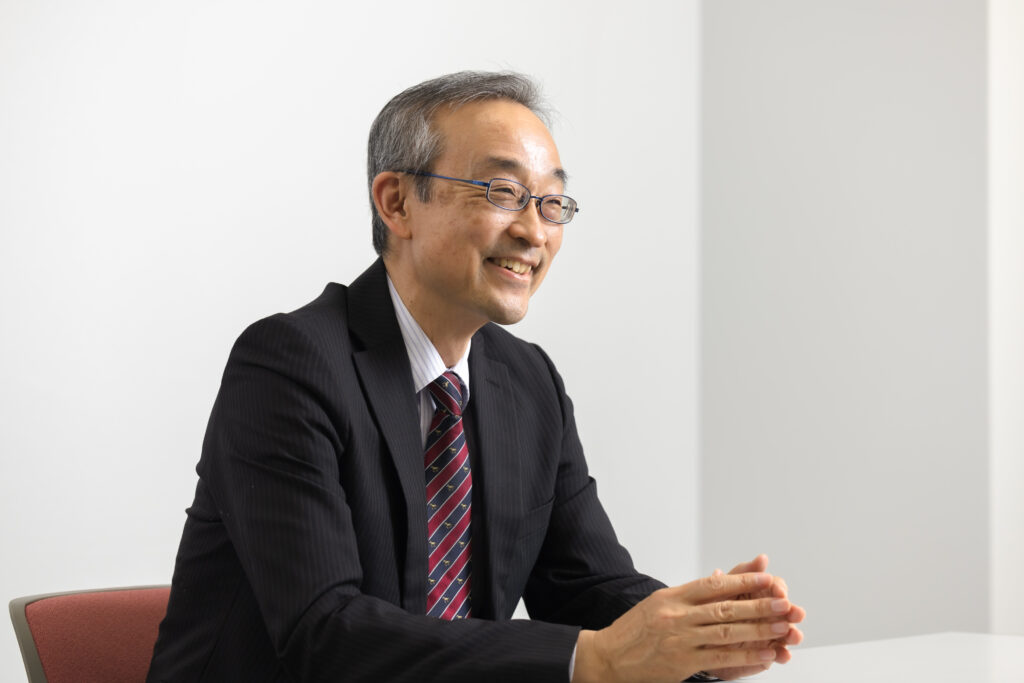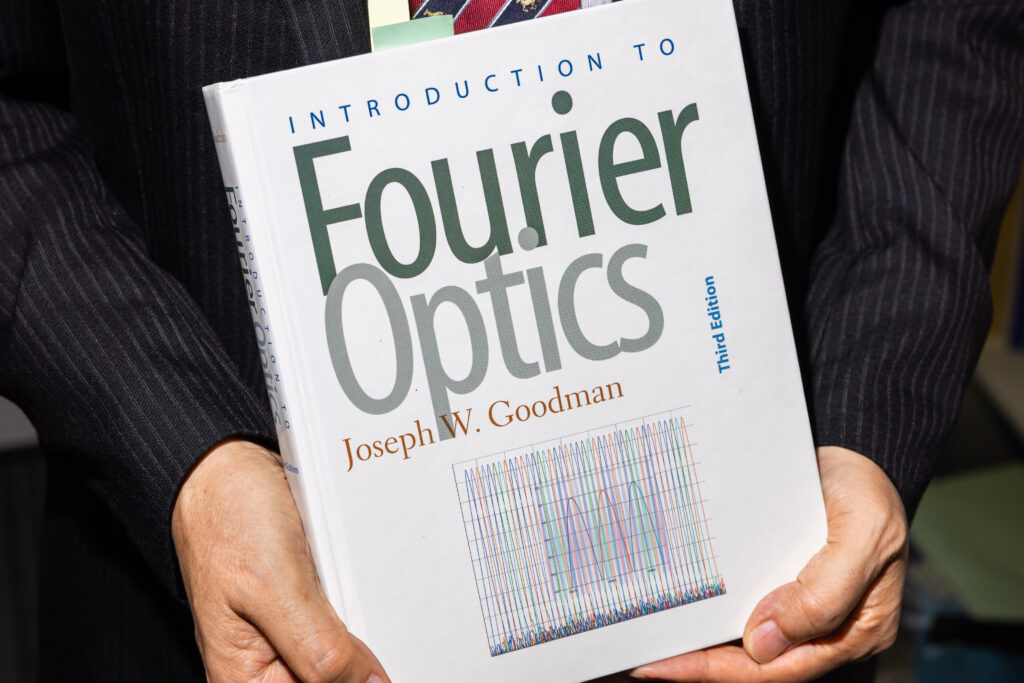
Professor Hiroshi Takahashi of the Faculty of Science and Technology is a specialist in optical fiber communication, researching next-generation communications using optical circuits. Optical circuits are a new technology that process light without converting it to electricity first. Professor Takahashi talks about their appeal and the future that massive amounts of ultra-high-speed communication will bring.
What today’s information-oriented society needs is technologies that can handle the rapid increase in communication volumes. While the 5G wireless communication service is becoming more popular, the next-generation 6G has a lot of hurdles to clear in terms of both technology and costs.
To solve this issue, I am conducting research for utilizing optical fiber communication technology and signal processing using light, that I have been working on for many years, in mobile networks.
In conventional optical communication, digital signals of “0” or “1” are converted to laser light pulses, and this string of pulses is sent via an optical fiber. By adding light of other wavelengths (other colors) and sending them together, we can increase the information. For example, if we can send 10 gigabits per second for each wavelength, if we have 80 wavelengths, we can send 800 gigabits per second. This is called wavelength-division multiplexing.
Before coming to Sophia, I worked for NTT Laboratories and developed an arrayed waveguide grating wavelength demultiplexer, a device to split light that includes multiple wavelengths all mixed together. This has been commercialized, and is now being used in optical communication networks that connect cities and continents.
Optical circuits: low-cost, energy-saving next-generation devices

However, there is a limit in wavelength multiplexing. To overcome this issue, multi-level modulation technique is now being used.
Light is an electromagnetic wave and given as an oscillating sinusoidal function of time. If we change oscillation timing (called phase) according to information, the phase expresses the information. In multi-level phase modulation, we can send more information per wavelength than those in conventional light pulse modulation. In other words, one signal contains several bits, instead of only one.
On the receiving side, the optical signal is converted into an electrical signal, and then the digital information is reproduced based on the light phase values using a large-scale integrated circuit (LSI), but this has the problem of requiring a lot of calculations and consuming a lot of electric power.
But we can reduce the calculations and reduce costs and power consumption for the receiver by pre-processing light using optical circuits immediately before it is received at light detector. My research is on these optical circuits. I use photolithography technology to etch glass films which has been formed on the surface of silicon substrates to make optical circuits.
While we can manipulate the status of the light passing through, depending on how the circuit is designed, the key part of optical circuit research is how deeply we understand things like the light phenomena such as interference and diffraction, and the basic principles of communication.
Optical circuit configuration itself is vastly simpler than LSIs, and one of the interesting aspects of this research is that we can perform experiments and check the proposed ideas and theory immediately.
A future society that allows high-volume, ultra-high-speed communication
Achieving ultra-high-speed communication of massive amounts of information through optical fiber communication will change our daily lives drastically. For example, grandparents living far away can link to their grandchildren’s house through the internet, showing each other’s rooms in real time on large screens covering the entire wall, sharing voice as well, which would create the sense that all of them are living together.
Currently only a handful of specialists can use advanced information systems that utilize AI, but these will be able to be used by the general public as well. In addition, virtual tourism and virtual reality will improve, and we may be able to get the feeling of truly being there.
Communication technology is a vital part of today’s information-oriented society. I’d like to create optical circuits that will form the foundation for the next generation.
The book I recommend
“Introduction to Fourier Optics Third Edition”
by Joseph W. Goodman, Roberts & Company Publishers

This was the optics textbook I read in a seminar in my fourth year at university. My research at that time focused on ultrasound, so it was hard to study optics, but eventually, I found this book very helpful when I started research optical circuits later. A noted work, it has gone through several editions, and I’m honored that the third edition actually mentions my own research on optical circuits.
-
Hiroshi Takahashi
- Professor
Department of Information and Communication Sciences
Faculty of Science and Technology
- Professor
-
After graduating from Tohoku University’s School of Engineering, he obtained his Master’s degree from the Graduate School of Engineering at the same university in 1988. He joined NTT Laboratories that same year, and obtained his Ph.D. in 1997. After serving as Research Group Leader and Distinguished Researcher at NTT Laboratories, he joined the faculty of Sophia in 2013.
- Department of Information and Communication Sciences
Interviewed: May 2022